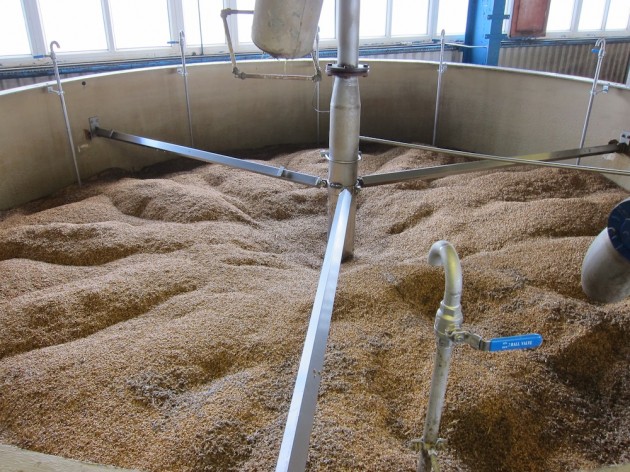
Single malt whiskies all have a single thing in common: they are all made from malted barley. Barley is a native grain to Scotland and grows extremely well and plentiful in Scotland’s maritime climate. On its own, a barley grain will malt, or sprout (can you imagine if it were called Single Sprouted Barley Whisky?), as part of its natural life cycle.
Whisky makers need this malted (or sprouted) barley year round, so outside of the two months of spring where it happens naturally, the barley needs to be forced to malt. The traditional way to malt barley was to lay it out on stone floors of fairly sizable buildings, wet it, rake it by hand, and then dry the grain on peat fires. This labor intensive process is still done at a select few distilleries, but the volumes needed for malted barley are too big for most to do it this way.
The History of Port Ellen Maltings
Port Ellen Maltings was built in 1972, when Islay whisky producers were experiencing extremely hard times. Over exuberant whisky forecasting and a sharp change in demand for whisky, due to vodka’s explosive growth, lead to a massive glut of whisky. This glut of whisky was extremely hard to sell, and often referred to as “Whisky Loch” (Americanized as Whisky Lake). Many distillers were forced to shut down production or completely close.
The Scottish Malt Distillers, owners of three distilleries on Islay at that time (Port Ellen, Caol Ila, and Lagavulin), decided to close the Port Ellen Distillery to build a centralized malting facility. This malting facility was called Port Ellen Maltings and helped the Scottish Malt Distillers save a considerable amount of money in producing their whisky through economies of scale and a reduction in the extremely labor intensive process of floor malting.

The Process of Malting
The process to malt barley is fairly basic, but the scale of the operation is massive. To malt barley, all you really have to do is trick it into thinking that it’s spring. Port Ellen Maltings does this with 8 steeping vessels, each with a 25 ton capacity.
To persuade the barley that it’s spring, the barley is soaked in vats for 2-3 hours with water from a loch located about 2 miles from the malting. The water is dark brown in color from the great amount of peat that’s on Islay, but none of the peat flavor you taste in a glass of whisky comes from this water (a big misconception). We’ve tasted the “peated” water and aside from the fact that it looks brown, it just tastes like water.
The first soaking of the barley really just gets into the outside of the grain (the husk) where all the controls of the grain are located. This starts the process of malting, and the barley is left to sit for ten hours as the malting process begins. Without water, the malting process would stop, so the barley is covered in water again and it is aerated. Aeration is mainly a mixing process to ensure that every grain of barley gets exposed to as much water as all the others. When the water is drained, the barley starts to grow. This process produces heat and carbon dioxide. The heat is important because it helps encourage the growth and reinforces ‘springtime’. Carbon dioxide is less helpful and, if left to build up, could stifle the growing process. Air is brought down through big pipes into the center of the tanks to draw fresh air into the mass of barley, which helps remove the carbon dioxide and encourages even growth of the barley. This process of soaking, aerating, draining, and air resting is done several times. Certain types of barley in certain conditions might only need this process twice, while others may need it more. At the end of the process, water completely permeates the grains of barley and the grain begins to show signs that it is starting to grow (typically a root and a shoot).

The barley that is malted in the tanks doesn’t come straight from the fields. A grain of barley has an internal clock which manages its dormancy phase – the period of time between when it’s harvested and when it will sprout. Barley is tested every month after harvest to see when the grain has “broken dormancy” and is ready to sprout. Grain harvested in September won’t malt until January or February of the following year at the earliest.
One of the reasons why barley is malted, fermented, and made into whisky is that it has a disproportionately large starch (which is also called endosperm) in relation to the grain’s embryo. Malting wakes the grain up, encourages it to produce enzymes which break down the endosperm, and release the starch which can be converted into fermentable sugars. These fermentable sugars are fairly well locked up by the grain which stores them inside an endosperm, and then inside cells which are inside starch granules. Malting helps break down these three layers before it gets to the distillery where the starches can be liberated and broken down into fermentable sugar. This process of breaking things down is all done by the grain naturally. Those sugars that a distiller turns into alcohol are the same sugars that the grain would turn into a barley plant.

Malting Barley and the Drums
After the barley grain is soaked, drained, and aerated several times, it’s dropped down into massive malting drums in batches of 50 tons of grain (two of the 25 ton soaking vats are paired and treated as a single batch). There are four 50 ton drums at the Port Ellen Maltings and they are the largest of their kind in Europe. The big advantage of using these drums is that each batch can be treated individually, and changes in temperature or conditions can be reacted to and adjustments made quickly. In the drum there is both space at the top of the drum above the malt and floor space below the grain which is perforated. As with the soaking vats, cool air is blown in to help control the temperature of the drum and to help exhaust carbon dioxide. This air helps cool things down but it’s not enough, so every 8 hours the drums are turned, 2 ½ times around in one direction, one time back, and a final half turn forward. This mixes up the malt and helps dissipate the heat.

As the barely begins to sprout inside the vats, it begins to develop roots and shoots. The roots from one grain can begin to entangle with the roots from other grains, mat up, and compact the batch of malt. This compaction stops the airflow, builds up heat, and throws the process out of control, so in addition to mixing and releasing heat, the turning of the drums also helps separate the barley grains. The sides of the drum aren’t flat – there are fins inside it which put natural stress on the grain and help separate the grains when the drums are turned. The fins are shaped like a corkscrew which help both in filling and emptying the vats. Vats are filled in one direction and then turned the opposite way to empty. The process in the vats is called modification and the process modifies a grain of barley into malt. The goal of the process is for everything to be modified and as much of the grain to be converted to starch or fermentable sugars. The process in the vats takes four days.
Getting Peat into Malt
After four days the malt is removed from the drums. This malt is called “green malt” and it still has enough moisture in it to continue to sprout and grow. This sprouting process is halted through a drying process. The malt is laid out on vented metal floors at a depth of four or five feet and warm, dry air from giant kilns is blown through the malt. There are two parts of the drying process. The first part deals with the water that is on the outside of the malt, and that takes low temperatures (55 degree heat) and high airspeed. The second half of the drying process deals with getting the water out from the inside of the malt. This is more difficult because it’s locked inside the grain, and so it takes low airspeed and high temperatures (70 degree heat). The point in the middle where it switches from one type of drying to the next is called “the break.”

The very important thing about the break is that phenols from peat smoke only get absorbed into the wet surface layer of the malt, so you can only attach peat to malt pre-break. At Port Ellent the pre-break process runs about half the 28-32 hours the malt goes through the drying process. Since the green malt is piled 4-5 feet high, the bottom of the pile reaches the breakpoint more quickly than the top and consequently absorbs less peat. The top layer of the pile gets the most peat and hits the break last, so the malt in a pile will have varying degrees of peat reek. Some of the whiskies with an extremely high amount of peat come from selectively harvesting malt from the top of the pile. Peat reek (or the elements from the peat smoke that are attached to the malt) are measured in PPMs (parts per million), with Lagavulin and Caol Ila both peating their malt to the same 35-40 PPM.

Drying the malt completely stops the sprouting process, but the grain still needs some time to settle down, let the enzymes get back into control, and let the whole thing rest. The malt is rested for three weeks, during which time Port Ellen Maltings does all their analysis on it to see how well it was modified, how many phenols it has, how much moisture remains in the grain, and ensures its up to the specification for their customers. The grain is loaded onto large grain trucks and then sent out to the distilleries.
Port Ellen Distillery has 30 different silos, each holding 100 tons of grain. A large distillery like Caol Ila can go through as much as 338 tons of malt a week.
















